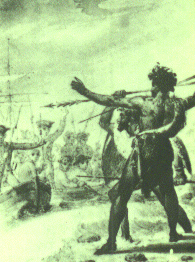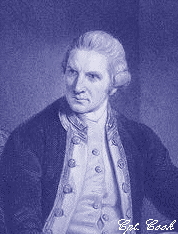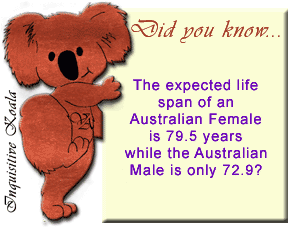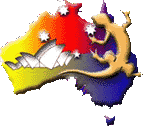




 |
AUSTRALIA
~
The First Inhabitants ~
Little is known of the early
history of Australia's Aboriginal peoples, who have probably lived
on the continent for more than 60,000 years. Australia's
Aboriginal peoples are not a single homogenous group. There are
several hundred distinctly different language and clan groups, who
share but a few common words. Many Aboriginal peoples were
traditional hunters and gatherers, moving with the seasons and
taking with them only possessions necessary for hunting,
collecting and preparing food such as the boomerang and the
woomera (a spear thrower). There is evidence of more complex land
management practices such as controlled burning of grasslands,
pointing to sophistication beyond simple hunter-gatherer status.
 At the time of contact with
Europeans, Aboriginal societies were organised within intricate
kinship relationships based on strictly applied laws and
observances. Complex marriage customs eliminated inbreeding and
maintained kinship ties between clans. Each family was a
self-sufficient economic unit with every member having
well-defined responsibilities, embedded in a sharing and
egalitarian culture. There was no formal government as we know it,
and authority was based on knowledge and religious/spiritual
experience. At the time of contact with
Europeans, Aboriginal societies were organised within intricate
kinship relationships based on strictly applied laws and
observances. Complex marriage customs eliminated inbreeding and
maintained kinship ties between clans. Each family was a
self-sufficient economic unit with every member having
well-defined responsibilities, embedded in a sharing and
egalitarian culture. There was no formal government as we know it,
and authority was based on knowledge and religious/spiritual
experience.
Social control was maintained by
way of rights and responsibilities towards other people. Complex
systems of belief, finding expression in oral literature, art,
songs, dances and social and kinship relationships, bound
Aboriginal peoples together. Knowledge of the Dreamtime-the
complex and interconnected value system which binds individuals
together before birth to after death-was passed from generation to
generation to secure the continuance of one of the oldest and most
enduring cultures in the world.
As early as the second century AD
theories of a great southland or Terra Australis to balance the
landmasses of the northern hemisphere were proposed in Europe.
Although Chinese and Arab sea captains may have landed in northern
Australia before AD 1000, Australia remained unexplored by the
West until the 17th century.
 European
contact with the Australian continent was a by-product of 16th and
17th century mercantile expansion in Asia by Portugal, Spain and
Holland. In 1606, Spanish navigator Luis Vaez de Torres sailed
through the strait which now bears his name. In the same year, a
Dutch ship, Duyfken, at Cape York made the first authenticated
landing in Australia. In 1642, Dutchman Abel Tasman reached
Tasmania, which he named Van Diemen's Land. Other sightings and
landings occurred, but it was not until 1770 that the more fertile
east coast was sighted by Captain
James Cook, of the British Royal Navy. European
contact with the Australian continent was a by-product of 16th and
17th century mercantile expansion in Asia by Portugal, Spain and
Holland. In 1606, Spanish navigator Luis Vaez de Torres sailed
through the strait which now bears his name. In the same year, a
Dutch ship, Duyfken, at Cape York made the first authenticated
landing in Australia. In 1642, Dutchman Abel Tasman reached
Tasmania, which he named Van Diemen's Land. Other sightings and
landings occurred, but it was not until 1770 that the more fertile
east coast was sighted by Captain
James Cook, of the British Royal Navy.
Copyright
unknown


History Index

|





 |
